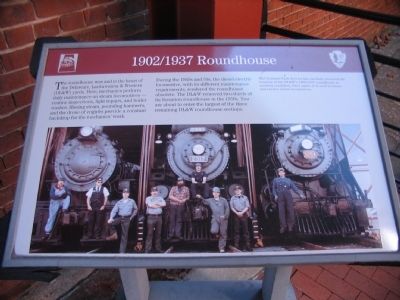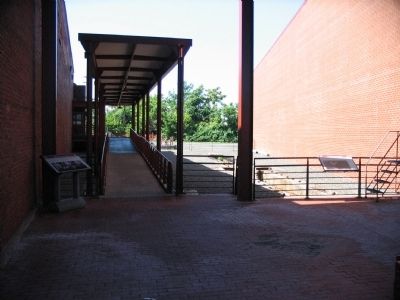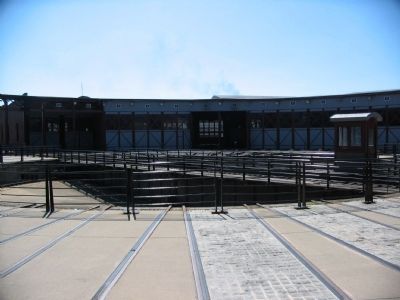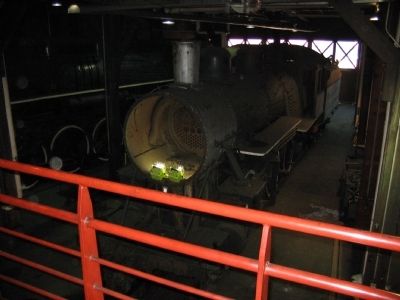Scranton in Lackawanna County, Pennsylvania — The American Northeast (Mid-Atlantic)
1902/1937 Roundhouse
During the 1940s and 50s, the diesel electric locomotive, with its different maintenance requirements, rendered the roundhouse obsolete. The DL&W removed two-thirds of its Scranton roundhouse in the 1950s. You are about to enter the largest of the three remaining DL&W roundhouse sections.
The National Park Service has carefully restored the remains of the DL&W's 1902/1937 roundhouse to working condition. Once again, it is used to house and service steam locomotives.
Erected by Steamtown Nataionl Historic Site - National Park Service.
Topics. This historical marker is listed in this topic list: Railroads & Streetcars.
Location. 41° 24.416′ N, 75° 40.28′ W. Marker is in Scranton, Pennsylvania, in Lackawanna County. Marker can be reached from Mechanic Street, on the right when traveling east. Located in the Roundhouse in Steamtown National Historic Site. Touch for map. Marker is in this post office area: Scranton PA 18503, United States of America. Touch for directions.
Other nearby markers. At least 8 other markers are within walking distance of this marker. 1902/1937 Inspection Pit (here, next to this marker); Pennsylvania Boxcars (within shouting distance of this marker); 1865 Inspection Pit (within shouting distance of this marker); Turntable (within shouting distance of this marker); E.J. Lavino & Company #3 (within shouting distance of this marker); New Haven Trap Rock Company #43 (within shouting distance of this marker); 1902 Roundhouse Section (within shouting distance of this marker); CNJ #5 Steam Derrick (within shouting distance of this marker). Touch for a list and map of all markers in Scranton.
Also see . . .
1. Steamtown National Historic Site. National Park Service site. (Submitted on June 10, 2009, by Craig Swain of Leesburg, Virginia.)
2. Virtual Tour of the Roundhouse. (Submitted on June 10, 2009, by Craig Swain of Leesburg, Virginia.)
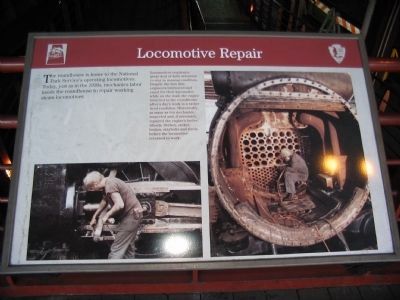
Photographed By Craig Swain, July 25, 2008
5. Locomotive Repair
Interpretive marker inside the roundhouse:
The roundhouse is home to the National Park Service's operating locomotives. Today, just as in the 1930s, mechanics labor inside the roundhouse to repair working steam locomotives.
Locomotives required a great deal of daily attention to stay in running condition. Despite the fact that engineers lubricated and cared for their locomotive while on the road, the engine returned to the roundhouse after a day's work in a rather tired condition. Historically, as many as ten mechanies inspected and, if necessary, repaired the engine's boiler, wheels, firebox, stoker, brakes, staybolts, and rivets before the locomotive returned to work.
The roundhouse is home to the National Park Service's operating locomotives. Today, just as in the 1930s, mechanics labor inside the roundhouse to repair working steam locomotives.
Locomotives required a great deal of daily attention to stay in running condition. Despite the fact that engineers lubricated and cared for their locomotive while on the road, the engine returned to the roundhouse after a day's work in a rather tired condition. Historically, as many as ten mechanies inspected and, if necessary, repaired the engine's boiler, wheels, firebox, stoker, brakes, staybolts, and rivets before the locomotive returned to work.
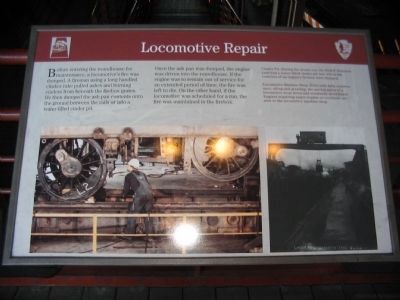
Photographed By Craig Swain, July 25, 2008
6. Locomotive Repair
Another interpretive marker inside the roundhouse:
Before entering the roundhouse for maintenance, a locomotive's fire was dumped. A fireman using a long-handled clinker rake pulled ashes and burning cinders from beneath the firebox grates. He then dumped the ash pan contents onto the ground between the rails or into a water-filled cinder pit.
Once the ash pan was dumped, the engine was driven into the roundhouse. If the engine was to remain out of service for an extended period of time, the fire was left to die. On the other hand, if the locomotive was scheduled for a run, the fire was maintained in the fire box.
Before entering the roundhouse for maintenance, a locomotive's fire was dumped. A fireman using a long-handled clinker rake pulled ashes and burning cinders from beneath the firebox grates. He then dumped the ash pan contents onto the ground between the rails or into a water-filled cinder pit.
Once the ash pan was dumped, the engine was driven into the roundhouse. If the engine was to remain out of service for an extended period of time, the fire was left to die. On the other hand, if the locomotive was scheduled for a run, the fire was maintained in the fire box.
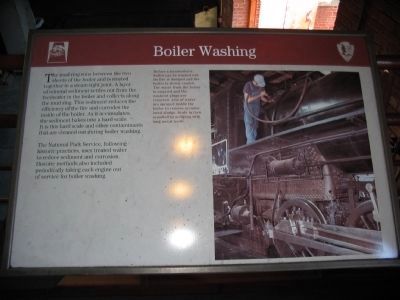
Photographed By Craig Swain, July 25, 2008
7. Boiler Washing
The mud ring runs between the two sheets of the boiler and is riveted together in a steam-tight joint. As a layer of mineral sediment settles out from the feedwater in the boiler and collects along the mud ring. This sediment reduces the efficiency of the fire and corrodes the inside of the boiler. As it accumulates, the sediment bakes into a hard scale. It is this hard scale and other contaminants that are cleaned out during boiler washing.
The National Park Service, following historic practices, uses treated water to reduce sediment and corrosion. Historic methods also included periodically taking each engine out of service for boiler washing.
The National Park Service, following historic practices, uses treated water to reduce sediment and corrosion. Historic methods also included periodically taking each engine out of service for boiler washing.
Credits. This page was last revised on June 16, 2016. It was originally submitted on June 10, 2009, by Craig Swain of Leesburg, Virginia. This page has been viewed 864 times since then and 18 times this year. Photos: 1, 2, 3, 4. submitted on June 10, 2009, by Craig Swain of Leesburg, Virginia. 5, 6, 7. submitted on June 13, 2009, by Craig Swain of Leesburg, Virginia.
